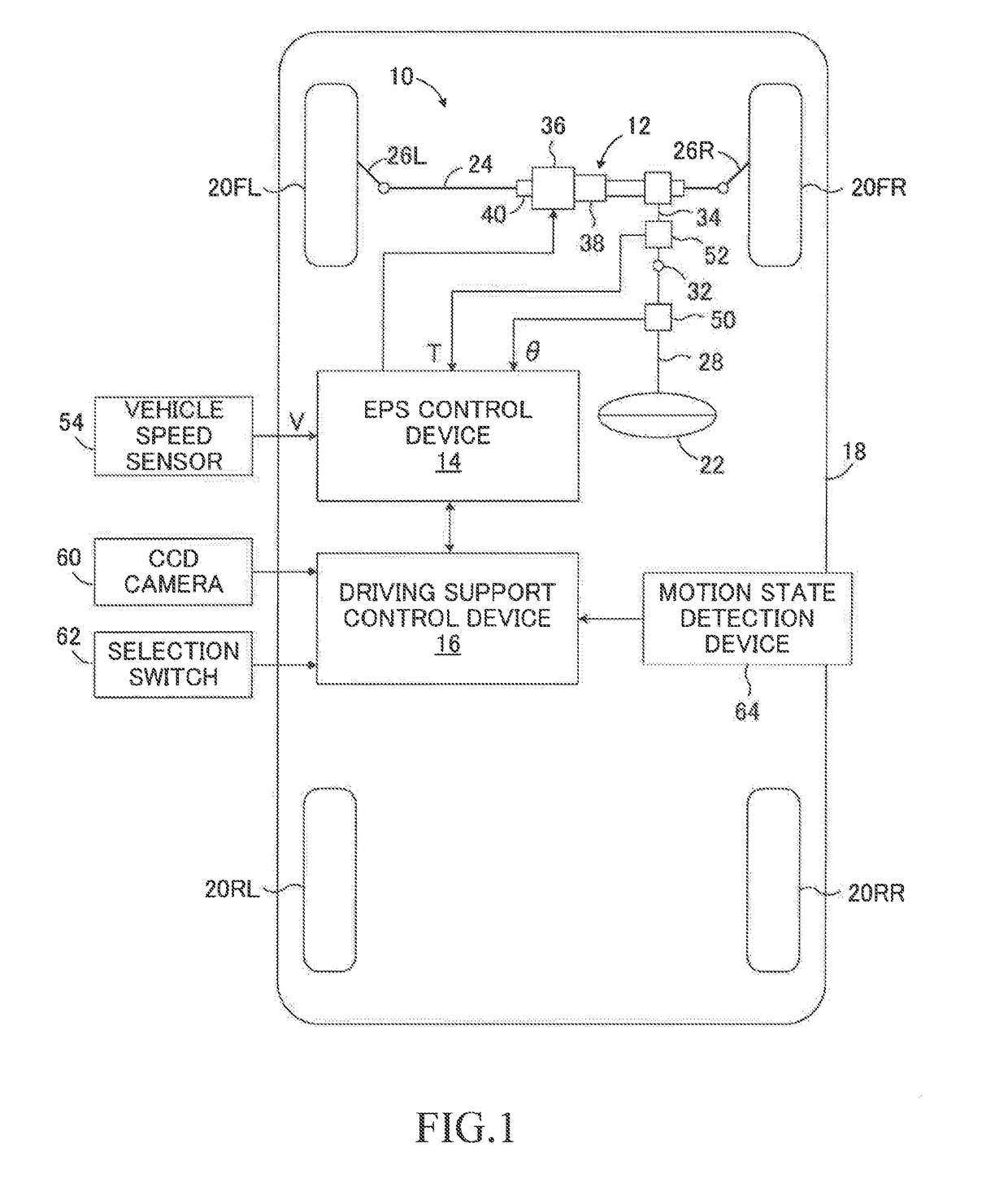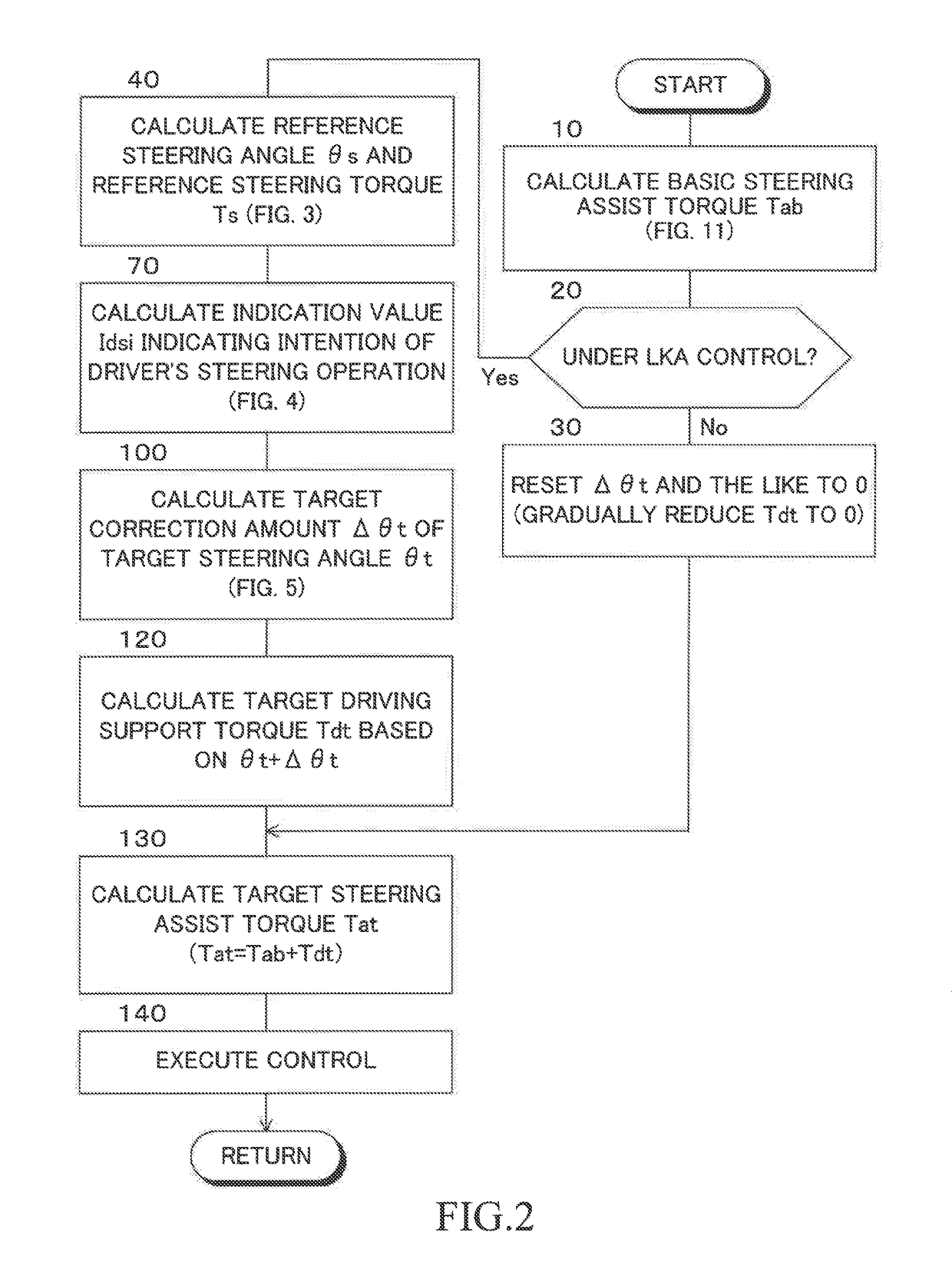Driving support device for vehicle
- Summary
- Abstract
- Description
- Claims
- Application Information
AI Technical Summary
Benefits of technology
Problems solved by technology
Method used
Image
Examples
first exemplary embodiment
[0077]Now, referring to the accompanying drawings, exemplary embodiments of the present disclosure are described in detail.
[0078]FIG. 1 is a schematic configuration diagram for illustrating a driving support device 10 according to a first exemplary embodiment of the present disclosure. The driving support device 10 includes an electric power steering (EPS) device 12, an EPS control device 14 serving as a control device configured to control the electric power steering device 12, and a driving support control device 16. The driving support device 10 is applied to a vehicle 18.
[0079]As illustrated in FIG. 1, the vehicle 18 includes front left and right wheels 20FL and 20FR, which are steered wheels, and rear left and right wheels 20RL and 20RR, which are non-steered wheels. The front wheels 20FL and 20FR are steered via a rack bar 24 and tie rods 26L and 26R by the electric power steering device 12 driven in response to an operation by a driver on a steering wheel 22. The steering whe...
second exemplary embodiment
[0164]FIG. 7 is a flowchart for illustrating an exemplary routine for controlling a steering assist torque in an exemplary embodiment of the present disclosure. In FIG. 7, the same step as the step illustrated in FIG. 2 is denoted by the same step number as that assigned in FIG. 2. The same applies to a third exemplary embodiment and first-third modified examples of the present disclosure described later.
[0165]As can be understood from a comparison between FIG. 7 and FIG. 2, in the second exemplary embodiment, the reference steering angle θ s and the reference steering torque Ts are calculated in Step 40 in accordance with the flowchart illustrated in FIG. 8. Steps other than Step 40 of FIG. 7 are executed similarly to the case of the first exemplary embodiment.
[0166]As illustrated in FIG. 8, Steps 42-52 and Steps 58 and 60 are executed similarly to the case of the first exemplary embodiment. In Step 50, when a negative determination is made (No at Step 50), the control proceeds to ...
third exemplary embodiment
[0172]FIG. 9 is a flowchart for illustrating an exemplary routine of controlling a steering assist torque in the third exemplary embodiment.
[0173]In the first exemplary embodiment described above, when the weight coefficients A and B to be used for calculating the first product Pr1 in Step 72 of FIG. 4 are set to 1, the first product Pr1 is calculated in accordance with Expression (1).
Pr1=(θ−θs)(T−Tds) (1)
[0174]The intention of the driver for transitional steering is considered to be represented by a time derivative dPr1 of the first product Pr1. Thus, Expression (1) is time-differentiated to acquire Expression (2).
dPr1=dθ*(T−Tds)+(θ−θs)*dT (2)
[0175]Further, Expression (2) is time-integrated to acquire Expression (3). It is understood that the sum of the time integral dθ*(T−Tds) and the time integral (θ−θs)*dT can be acquired as the first product Pr1 from Expression (3).
Pr1=∫Pr1t=∫{θ*(T-s)+(θ-θs)*T}t=∫{θ*(T-Ts)}t+∫{(θ-θs)*T}t (3)
[0176]The product dθ*(T−Tds) of Expression (3) is th...
PUM
 Login to View More
Login to View More Abstract
Description
Claims
Application Information
 Login to View More
Login to View More - R&D
- Intellectual Property
- Life Sciences
- Materials
- Tech Scout
- Unparalleled Data Quality
- Higher Quality Content
- 60% Fewer Hallucinations
Browse by: Latest US Patents, China's latest patents, Technical Efficacy Thesaurus, Application Domain, Technology Topic, Popular Technical Reports.
© 2025 PatSnap. All rights reserved.Legal|Privacy policy|Modern Slavery Act Transparency Statement|Sitemap|About US| Contact US: help@patsnap.com



